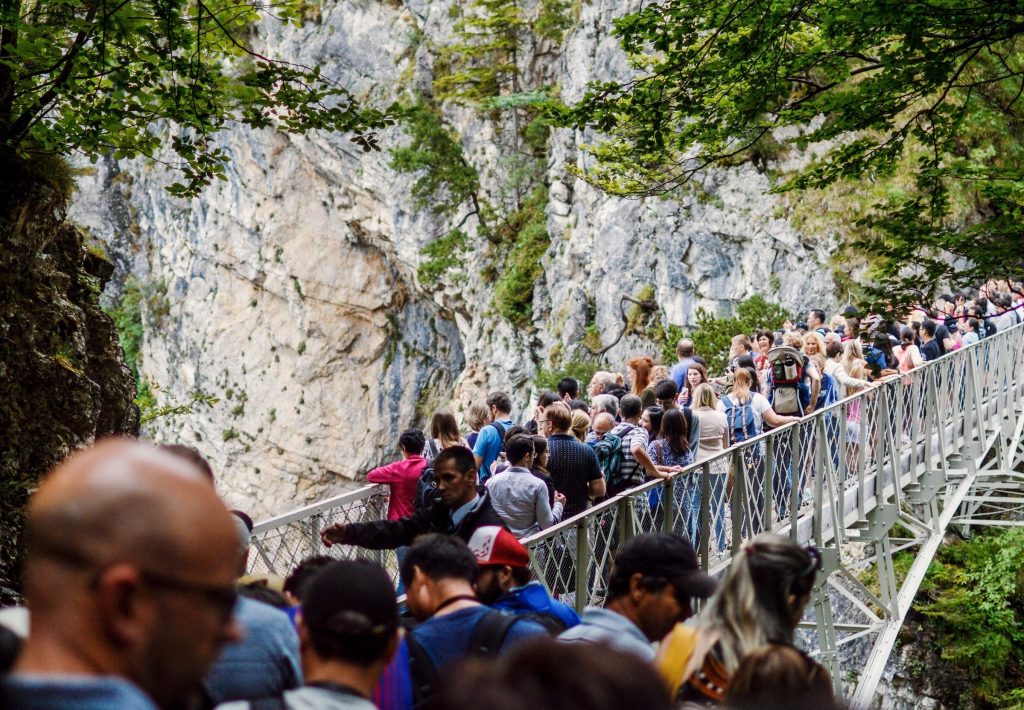The 12 consequences of global change in the mountains
[This article has been writen together with Carla Kuhleis, during her stay at CREAF doing an international communication internship.]
As dawn breaks at the Oulettes de Gaube refuge (France), Bernat Claramunt is ready to begin an expedition as a scientific guide in the Gaube valley, in the Pyrenees. As a CREAF ecologist and UAB professor expert on mountain systems, he knows the terrain well. This is why he cannot stop looking at the Glacier del Vignamale to note its retreat, even if it still looks imposing.
This time he is accompanied by a scientific research group seeking to measure the effects of climate change on the mountains. An activity that they will cover in 3 stages along the Pyrenees Natural Park, to cross the remains of the glaciers of the Vignamale massif, the most extensive on the northern slopes of the Pyrenees. Its aim is to gain first-hand knowledge of the state of the glaciers and the alpine vegetation, as well as to measure the characteristics of the lakes, the uses of meadows and pastures and the evolution of life in the valleys.
In the Pyrenees there is less and less water available, there are changes in plant and animal biodiversity, it is clear that the forest line is rising towards areas previously occupied only by meadows, and there is a new social reality in the small towns and villages.
During the journey, Bernat Claramunt is blunt: in the Pyrenees there is less and less water availability, changes in plant and animal biodiversity, it is evident that the forest line is rising to establish itself in areas previously occupied only by meadows, and there is a new social reality in the small towns and villages. In this scenario, glaciers are an undeniable paradigm: they are critically affected by rising temperatures. “Their size is getting smaller and smaller and they are thinner, and in the Pyrenees it is clear that they are disappearing”, says Claramunt. In this mountainous area all the glaciers have experienced an irreversible retreat, something evident in Aneto, Maladeta and Monte Perdido (in Aragon, Spain), as well as Ossoue and Marboré (in France). On French territory, Troumouse glacier has completely disappeared in the last 40 years, as in Catalonia, where there are no glaciers left today either.
Moving the vertical bar shows the before and after of global change in mountain areas and in people's lives:
Learn about the 12 global change hotspots in mountain areas:
Water, biodiversity and rural development
Providing water, guaranteeing biodiversity and facilitating the development of a sustainable socio-economic environment are some of the great benefits provided by mountain areas. In fact, they are benefits (or ecosystem services) provided to the entire European continent.
In their water tower function, mountain areas are responsible for supplying this essential commodity to half of the world’s population, as well as generating hydroelectric power for upland and lowland dwellers. As biodiversity hotspots, they are home to the majority of Natura 2000, Europe’s ecological network of protected areas. They also offer opportunities for leisure based on their natural attributes and cultural heritage.
Intense demand for the benefits provided by mountain areas adds pressure beyond the risk posed by climate change.
However, our society is increasingly demanding the services provided by mountain areas, adding pressure beyond climate change and putting them at greater risk. “It is time to consider new models of sustainable development for these regions”, according to Bernat Claramunt, who coordinates the European scientific network NEMOR, with about 40 organisations from all over Europe. According to the researcher, to ensure this sustainable development, a meeting point between scientific knowledge and public actions and policies will have to be determined. “Mutual understanding on how to address the current and future challenges of global change in mountain areas should be one of the priorities in Europe,” he says.

"Mutual understanding on how to address the current and future challenges of global change in mountain areas should be one of the priorities in Europe".
BERNAT CLARAMUNT, CREAF researcher, UAB professor and coordinator of the European network NEMOR.
Moreover, this common approach will have to take into account the challenges specific to each territory. “We know the major challenges in the mountains, but we need to describe them in detail for each region and determine how to proceed,” says Claramunt. There are still many unknowns about how to deal with global change in this environment, and there are still many research and knowledge gaps to be filled. For example, we consider the diversification of winter sports, which could potentially turn some areas into mountain resorts, to be beneficial, but we do not know the effect of the continued presence of visitors on the biodiversity of that area.
More humans, more heat, less water
The intense human presence, the rise in thermometers on the summits and the reduced availability of water are accelerating a new circumstance in mountain areas. The balance between enjoying nature and damaging it with our presence is a difficult reality, especially when it is frequent and without clear regulation. The Caucasus region, for example, warns of the effects of anthropogenic factors.

“The consequence of human pressure on the different ecosystems and biodiversity is quite severe, it alters their structures and functions and, consequently, impacts on the vital services for the well-being of the rural and urban population and on sustainable development of the region”, according to Mary Kate Ugrekhelidze, linked to Sustainable Caucasus, a network for the management and study of mountains, linked to the United Nations, which ensures the sustainable development of the mountainous areas of the 5 Caucasus countries ( Armenia, Georgia, Russia, Turkey and Azerbaijan) located between the Caspian and Black Seas, at the meeting point between Europe and Asia. They are also part of Sustainable Caucasus countries such as Austria and Switzerland.
The increase in average temperature leads to less precipitation and more water evaporation, which threatens mountain areas with an almost unprecedented risk of fire and less availability of fresh water.
The increase in average temperatures is resulting in lower precipitation and increased water evaporation, which threatens mountain areas in Europe and around the world. One of the main consequences is an increased risk of fire in these areas - almost non-existent until now - and a reduction in the availability of fresh water. This also has an impact on the river network. In southern Europe, one of the most affected rivers is the Ebro, which rises in the north of the Iberian Peninsula and flows into the Mediterranean coast. "Significant decreases of more than 50% of the annual flow have been recorded in its basin, specifically in the gauging stations studied from 1950 to 2010", according to the latest report by the Observatorio Pirenaico del Cambio Climático (OPCC), located in Huesca (Spain). This impact is already having a negative impact on water supply for irrigation, urbanisation, industrialisation and hydropower production. In other regions, climate change is having a different effect on rivers. The Danube, the second longest in Europe after the Volga, has already surpassed its highest level recorded in 1895. The floods caused by melting ice in Central and Eastern Europe and the increased frequency of torrential rains as a result of climate change threaten its course through Vienna (Austria), Bratislava (Slovakia), Belgrade (Serbia) and Budapest (Hungary).
A more distant tree line
The tree line is moving upwards, because warmer temperatures and longer snow-free seasons allow them to survive in areas where this was not possible before. Also, the high mountain cattle pressure that maintained the forest fringe has been reduced.
"And how does the landscape, the wildlife, react to all these changes?" asks Sara Costa, one of the scientists accompanying Bernat Claramunt on the expedition through the Pyrenees Natural Park. "I suggest you look at that peak with binoculars to identify where the forest reaches its limit. Thirty years ago there were no trees growing there", replies the CREAF researcher. In mountainous areas the tree line is moving upwards, because the increase in temperature and the long periods without snow allow them to survive in areas where it was not possible before. And also because the pressure from high mountain cattle, which maintained the forest fringe, has been reduced. Climate change forces many plant species and certain fauna to adapt their life cycle and distribution. The diversity of mountain micro-habitats offers climate refuge especially to small species: by moving a few metres they find conditions similar to those existing before the rise in temperatures. Some species will be able to adapt to the change in conditions - such as the shrub cover on the tundrafor now treeless tundra - and others are already affected and in danger of extinction. This is the case of animals such as the grouse, whose population has dwindled drastically due to human presence in the habitats it occupies in the subalpine forests of the Pyrenees and Pre-Pyrenees.

As a consequence of the progressive abandonment of traditional agricultural and livestock activities, subshrub species occupy the former pastures. This situation homogenises the ecosystems and leads to a silent loss of biodiversity on a large scale.
Mountain areas are also undergoing rapid economic, demographic, cultural and land-use transitions. One consequence of this is the progressive abandonment of traditional agricultural and livestock farming. The disused cultivated areas are occupied by sub-shrub species, which are gaining ground and occupying the former pastures. This situation homogenises ecosystems and leads to a silent loss of biodiversity on a large scale. In the lowlands, where agricultural practices and human activity are concentrated, this reality is also having consequences. For example, in Portugal, the Foundation for Science and Technology (FCT) warns that the Montesinho National Park is experiencing a decline in agricultural production due to harsh environmental conditions. "The increase in extreme weather events is causing farmers to either abandon production or be forced to install new, more efficient methodologies due to the lack of rainfall," explains Alberto Teixeira, researcher at the FCT. Beyond the threat to the environment and its benefits, the traditional way of life of people is also changing and will continue to do so more markedly. Further east, in the Caucasus region, this situation is also experienced as a threat. "The possible negative impact of weather changes would have irreversible repercussions on the socio-cultural and economic aspects of mountain populations," says Mary Kate Ugrekhelidze on behalf of the Sustainable Caucasus network.
Rethinking Mountain Villages
There is also an additional type of erosion in mountain areas, and it is the one that causes depopulation. It means loss of cultural heritage and, as a consequence, depletion of the socio-economic reality, as the villages become empty. The other side of the coin are the second homes with low occupancy rates in these areas, which end up becoming ghost neighbourhoods but which also demand resources for maintenance and services. However, as a result of the Covid19 pandemic, some mountain areas have experienced the opposite situation, due to the settlement of people in search of an alternative to the urban rhythm. Bernat Claramunt insists that this sudden growth of inhabitants means added pressure: greater demand for ecosystem services and the benefits provided by the mountains, as well as new challenges in terms of minimum geographical coverage of public transport, access to health and education systems and internet connection. Stefano Sala, from UNIMONT, a research and teaching centre linked to the University of Milan (Italy), underlines that "the impact of global change on the socio-economic assets of mountain areas has been aggravated by the Covid19 crisis".

However, the footprint of the Covid19 pandemic in mountain areas is still difficult to determine: "At NEMOR, we believe that a broader perspective is needed to understand its impact on the long-term occupation of mountain villages," says the CREAF scientist and UAB professor. The winter sports linked to snow, an essential branch for the economy of some mountain areas, have also been affected for years. In the Alps and Pyrenees, snowfall has declined over the last century and this trend is expected to continue. The retreat of glaciers, already evident in both the Pyrenees and the Alps, is a red flag. In the Pyrenees, snow accumulation below 1,500m could be reduced by 78% in the last quarter of the 21st century according to data from the OPCC. "According to the Third report on climate change in Catalonia prepared by the Generalitat de Catalunya, in 2050 we could have half the snow we have now, and this is losing a lot of snow," says Bernat Claramunt. As a result, the Pyrenean and Alpine ski resorts are expected to become less attractive for winter tourism, which will completely disrupt the economy of these areas.

"According to the Third report on climate change in Catalonia prepared by the Generalitat de Catalunya, in 2050 we could have half the snow we have now, and this is losing a lot of snow".
BERNAT CLARAMUNT, CREAF researcher, UAB professor and coordinator of the European network NEMOR.
"What can we do then to maintain this activity, if it is so essential, Bernat?", asks Sara Costa again. A few fleeting ideas run through Bernat's head, but he replies: "This question is more for a person with political decision-making power, not for a specialist in ecology like me... As an ecologist I can tell you that when it comes to planning how we adapt to this new reality posed by winter sports, both society and political management should be aware of the environmental costs that each adaptation measure may entail, based on scientific knowledge, and decide together whether we want to assume them".
Some homework done
"Have any European countries done their homework?" Again, a question from the group of specialists noting global change in the mountains. Yes, the reality of mountain areas is part of the political discourse - both locally and globally - and some European countries have enacted specific laws, while others have adopted more sectoral approaches, oriented towards biodiversity or forest management. Specific programmes are underway in some European countries, promoting regional cooperation against the vulnerability of mountain people to extreme weather events, induced by climate change (heat waves, sudden and intense storms, drastic temperature drops, floods, etc.). There are also specific projects on water management and the study and adaptation to climate change, such as cross-border cooperation initiatives.

In any case, Europe has yet to promote a common research agenda and a common political strategy on mountain regions. NEMOR points out the urgency of promoting this agenda, the need to define the actions associated with it and a mutual understanding, as well as the need to adapt it to each reality.
It would be desirable that the evidence from scientific expeditions in the field be useful for applying scientific criteria to political guidelines and actions.
The expedition ends its journey in the Gavarnie mountain range where the retreat of perpetual snow is still very evident, in this case on the Marboré, Taillón and Gabietos glaciers. "We are on the northern slope, in an area with a high altitude where the glaciers were a real water reserve... this very evident and accelerated retreat is the step prior to their complete disappearance", reflects Bernat Claramunt. Hopefully, the results of scientific expeditions such as this one will be useful for applying scientific evidence to political guidelines and actions.
[This article has been writen together with Carla Kuhleis, during her stay at CREAF doing an international communication internship.]







